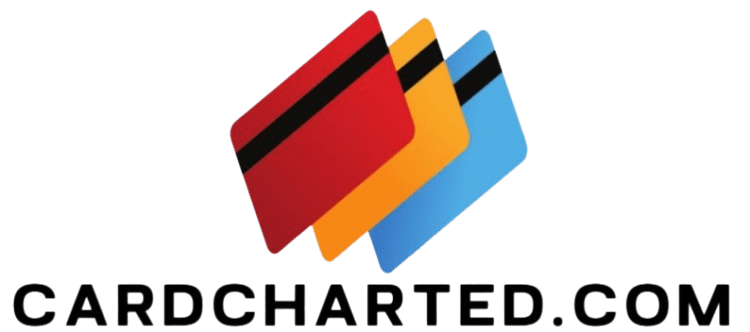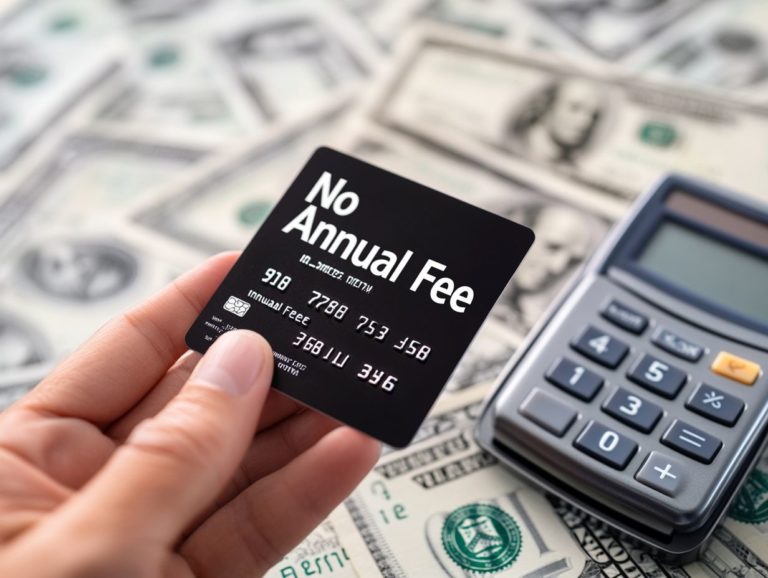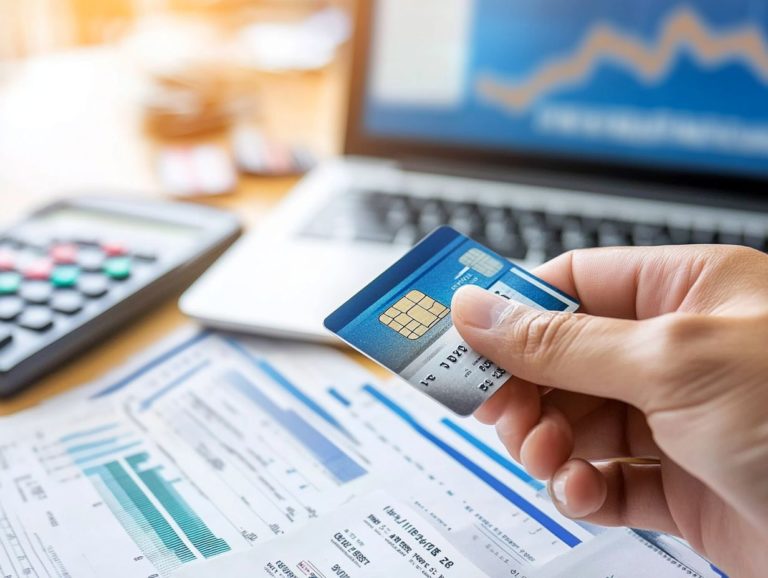What to Do If You’ve Reached Your Credit Limit
Understanding your credit limit is essential in today s financial landscape. It influences not only your purchasing power but also has a significant impact on your credit score.
This guide will explore what happens when you reach your credit limit, the potential consequences and fees you may encounter, and effective strategies for repayment.
You ll also discover alternative financing options and best practices for managing your credit, helping you avoid hitting that limit in the first place.
Start taking control of your financial future right now!
Contents
Key Takeaways:

- Don’t panic if you’ve reached your credit limit it happens to many people.
- Know the real impact of reaching your credit limit it’s crucial to your financial future!
- Consider alternative financing options and develop a repayment strategy to avoid further financial strain.
Understanding Credit Limits
Understanding credit limits is essential for keeping your finances healthy. These limits represent the maximum amount your credit card issuer permits you to borrow. Several factors influence these limits, including your credit score, spending patterns, and payment history.
A clearly defined credit limit enables you to manage your credit utilization effectively. This helps you steer clear of the pitfalls associated with overspending, which can lead to penalties and fees.
Understanding how to set and adjust your credit limits can improve your budgeting skills and contribute to your overall financial well-being.
Definition and Importance
A credit limit is the maximum amount that a credit card issuer like Capital One or Citibank allows you to spend on your credit card accounts. It s a crucial element in managing your financial health.
Establishing a reasonable credit limit is essential for responsible credit management. It helps you keep your spending in check and avoid the dangers of debt.
Your credit utilization ratio is how much credit you’re using compared to how much you have available. A lower utilization ratio is generally seen as favorable and can enhance your credit scores, making it easier for you to secure loans or additional credit in the future.
Monitor your spending within these limits to build a strong financial foundation that enhances your creditworthiness and overall financial health.
What Happens When You Reach Your Credit Limit
Reaching your credit limit and maxing out your credit card can trigger a cascade of negative outcomes. You may experience declined transactions, along with potential penalties and fees that could worsen your financial situation.
It’s essential to be mindful of your credit utilization to maintain your financial health and avoid unnecessary stress.
Consequences and Fees

Maxing out your credit card can lead to serious consequences, including over-limit fees and penalties that can harm your credit score. This may result in higher interest rates for future transactions.
When you exceed your limit, you might find yourself under immediate financial strain, as those fees can accumulate more quickly than you d like. An over-limit status not only incurs direct costs but also signals a red flag to lenders, indicating a potential pattern of irresponsible borrowing, which can diminish your creditworthiness.
Over time, this can restrict your access to favorable loans or credit products. It s essential to familiarize yourself with the terms and conditions tied to your credit accounts. Understanding these intricacies is key to better financial management and maintaining a healthy credit profile.
Options for Dealing with a Maxed Out Credit Limit
Faced with a maxed-out credit limit? It can feel overwhelming, but there are several effective strategies available to help you regain control.
Consider options like debt consolidation, seeking credit counseling, or implementing a structured payment plan. These approaches can help you manage your monthly payments and pave the way toward financial stability.
Don’t wait! Start implementing these strategies today.
Strategies for Repayment
Effective repayment strategies, like the debt snowball and debt avalanche methods, can greatly assist you in managing monthly payments on maxed-out credit cards while enhancing your overall financial health.
These approaches promote a systematic repayment process, enabling you to take control of your debt and instill a sense of accomplishment along the way.
The debt snowball method encourages you to tackle the smallest balance first, providing those satisfying quick wins that can boost your motivation. On the flip side, the debt avalanche strategy prioritizes high-interest debts, ultimately saving you money over time.
To create a sustainable payment plan, it’s essential for you to evaluate interest rates and maintain a low credit utilization rate (the amount of credit you re using compared to your total credit limit) aiming for under 30% of your available credit.
Regularly reviewing and adjusting your budget can help you accommodate additional payments, making your journey toward financial freedom much smoother.
Alternative Financing Options
When you find yourself facing a maxed-out credit limit, considering alternative financing options can offer you much-needed relief.
Services like credit counseling or balance transfer credit cards can help you manage your emergency fund more effectively. You might also explore programs such as SoFi, which provides personal loans at competitive interest rates, or the Capital One Money & Life Program, tailored to help you achieve your financial aspirations.
Each of these options comes with its own set of pros and cons. For example, SoFi is great for those looking for lower rates and no fees, but it may require a solid credit score for approval. The Capital One program offers comprehensive financial planning tools but may not directly address immediate debt concerns.
By integrating these financing solutions into a broader financial strategy, you can tackle short-term challenges while paving the way for long-term financial stability.
How to Avoid Reaching Your Credit Limit

Avoiding the pitfalls of hitting your credit limit requires effective credit management techniques. This includes practicing diligent budgeting, closely monitoring your spending habits, and maintaining your credit usage levels within the recommended thresholds.
Best Practices for Credit Management
Implementing best practices for credit management can boost your financial health dramatically. This includes responsible budgeting, monitoring credit card limits, and adjusting your spending habits accordingly.
A highly effective strategy is to create a detailed budget worksheet that outlines your monthly income, expenses, and savings goals. By categorizing your expenditures, you can pinpoint areas where you might be overspending, enabling you to make informed financial decisions.
Setting reminders for monthly payments is another key tactic; this ensures bills are paid on time, helping you sidestep late fees and potential harm to your credit score.
These approaches not only bolster your financial discipline but also promote healthier credit utilization, laying a solid foundation for future borrowing and investment opportunities.
Monitoring Your Credit Utilization
Monitoring your credit utilization is essential for maintaining a healthy credit score. It reflects your payment history and your overall credit management.
You can easily track this through tools like CreditWise or resources offered by the Consumer Financial Protection Bureau. Make it a habit to check your credit reports frequently for the best outcomes!
Understanding the implications of high utilization ratios allows you to take proactive steps to enhance your credit health. Regularly reviewing your credit reports can uncover valuable insights about your spending habits and highlight potential areas for improvement.
Setting up alerts or reminders to pay off balances before they impact your utilization ratio is a smart strategy. By establishing a budget that prioritizes timely payments and keeps your balances low, you can further elevate your credit score.
Engaging with tools that visualize credit changes enables you to make informed decisions, ensuring your credit journey remains on a positive path.
Frequently Asked Questions
If you’re ready to take the first step towards better credit management, start implementing these strategies today!
What to Do If You’ve Reached Your Credit Limit?

If you’ve reached your credit limit, take immediate action. You can manage your credit effectively to avoid hurting your finances.
Can I still use my credit card if I’ve reached my credit limit?
No. You cannot make any purchases using your credit card until you pay down your balance.
What happens if I go over my credit limit?
Going over your credit limit can lead to extra fees and a drop in your credit score. Avoid this to keep your finances healthy!
How can I avoid reaching my credit limit?
Track your spending closely and budget wisely. Consider asking your credit card issuer for a limit increase if you pay on time.
What are my options if I’ve reached my credit limit?
You can pay down your balance to free up credit. Alternatively, use a different payment method for your purchases.
Will reaching my credit limit affect my credit score?
Yes, reaching your limit shows high credit use, which can hurt your score. Keep your credit utilization below 30% to maintain a strong score!






